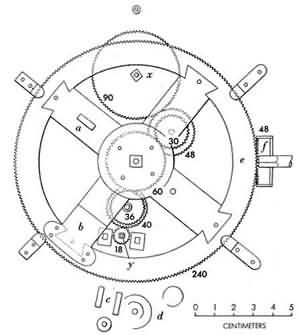
Just came across the official website of the Antikythera Mechanism Research Project. It is the website of the scientists and scholars who are studying the Antikythera Mechanism. Here is a description of the project from the website.
More than a hundred years ago an extraordinary mechanism was found by sponge divers at the bottom of the sea near the island of Antikythera. It astonished the whole international community of experts on the ancient world. Was it an astrolabe? Was in an orrery or an astronomical clock? Or something else? For decades, scientific investigation failed to yield much light and relied more on imagination than the facts. However research over the last half century has begun to reveal its secrets. It dates from around the 1st century B.C. and is the most sophisticated mechanism known from the ancient world. Nothing as complex is known for the next thousand years. The Antikythera Mechanism is now understood to be dedicated to astronomical phenomena and operates as a complex mechanical “computer” which tracks the cycles of the Solar System.
Previous researchers have used the latest technologies available to them-such as x-ray analysis-to try to begin to unravel its complex mysteries. Now a new initiative is building on this previous work, using the very latest techniques available today. The Antikythera Mechanism Research Project is an international collaboration of academic researchers, supported by some of the world’s best high-technology companies, which aims to completely reassess the function and significance of the Antikythera Mechanism. Results are already very promising.
The project is under the aegis of the Hellenic Ministry of Culture and is supported by a grant from the Leverhulme Trust, UK. It has received strong backing from the National Archaeological Museum in Athens, which is custodian of this unique artefact. Two of the Museum’s senior staff, Head of Chemistry, Eleni Magkou, and Archaeologist, Maria Zafeiropoulou, have co-ordinated the Museum’s side of the project and are actively involved with the research.
One UK and two Greek universities are the core of the academic research group-the astronomer Mike Edmunds and the mathematician Tony Freeth (University of Cardiff), the astronomer John Seiradakis (University of Thessalonica), the astronomer Xenophon Moussas and the physicist, Yanis Bitsakis (University of Athens). And last, but not least, the philologist and palaeographer Agamemnon Tselikas (NBG Cultural Foundation).
The URL for the Antikythera Mechanism Research Project website is as follows:
helo how are you